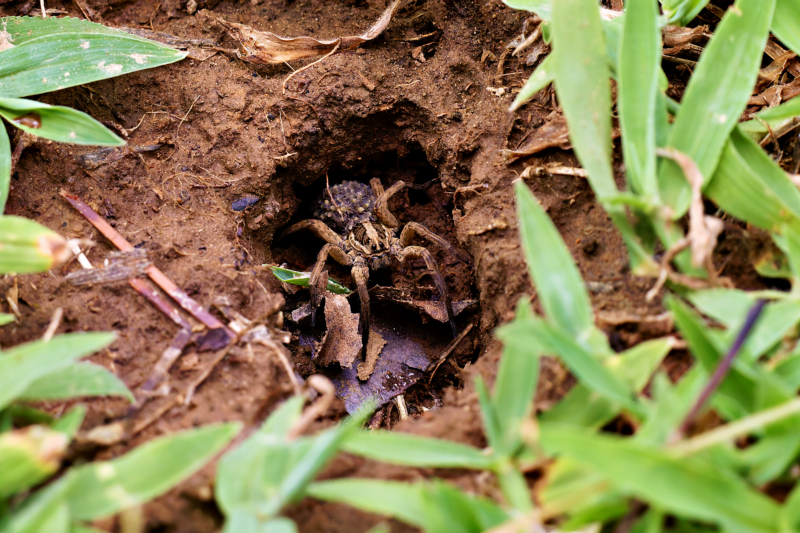Yesterday, as I was picking up limbs that had fallen after a storm, I noticed something intriguing—a hole in the ground with a spider lurking at its entrance. On closer inspection, I realized it was a Wolf Spider. Excited by this find, I ran inside to grab my camera and began photographing the spider. To my amazement, I saw that the spider had baby spiders clinging to its back. This moment led me to dive deeper into the fascinating world of wolf spiders and their unique parental care.

Maternal Dedication and Care
Wolf spiders are renowned for their exceptional maternal care, setting them apart from many other arachnids. Here are some fascinating facts about their behavior:
- Maternal Dedication: Female wolf spiders exhibit exceptional maternal care by carrying their egg sacs attached to their spinnerets (silk-producing organs) until the eggs hatch.
- Egg Sac Protection: The mother wolf spider is highly protective of her eggs, carrying the silk-encased sac wherever she goes, even while hunting.
- Hatching Process: When it’s time for the eggs to hatch, the mother wolf spider helps tear open the egg sac to release her spiderlings.
- Instinctive Behavior: Upon hatching, the baby spiders instinctively climb onto their mother’s back.
- Large Brood Size: A female wolf spider can carry approximately 100 or more babies on her back at once.
- Duration of Care: The mother carries her spiderlings for several days, allowing them time to grow and develop before they become independent.
- Unique Among Spiders: Wolf spiders are the only known spider species to carry their young on their backs.
- Survival Strategy: This behavior significantly increases the survival rate of the offspring.
- Maternal Sacrifice: During the time she carries her young, the mother wolf spider may not feed, potentially risking starvation to ensure her offspring’s survival.
- Visual Appearance: When carrying her young, the mother spider may be almost completely covered, with only her eyes visible beneath the mass of spiderlings.
- Reuniting Fallen Babies: If a baby spider falls off, the mother will stop and wait for it to climb back on.
- Hunting Ability: Despite carrying such a large number of offspring, the mother wolf spider can still hunt effectively.
- Dispersal: After about a week, the spiderlings leave their mother’s back and begin to fend for themselves.
- No Paternal Care: Male wolf spiders do not participate in caring for the young; the female is solely responsible for this task.
- Cannibalism: While on their mother’s back, the spiderlings do not eat. However, once they disperse, stronger spiderlings may eat weaker ones as they begin to fend for themselves.

A Glimpse into Nature’s Wonders
Witnessing the wolf spider with her brood was an unexpected and enriching experience. It’s incredible how these spiders showcase advanced parental care, ensuring the survival of their young in a challenging environment. This remarkable behavior highlights the intricate and often overlooked aspects of nature, making wolf spiders a subject of fascination for both scientists and nature enthusiasts alike.
Next time you’re out in your yard or exploring the wilderness, keep an eye out for these dedicated spider mothers. Their story is a beautiful reminder of the wonders of nature that surround us every day.

Very interesting and informative!